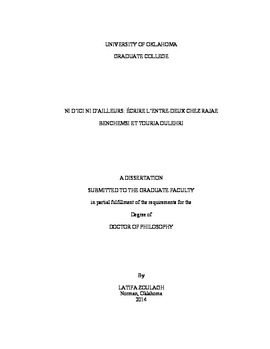| dc.contributor.advisor | Winston, Michael | |
| dc.contributor.author | Zoulagh, Latifa | |
| dc.date.accessioned | 2014-12-11T19:33:06Z | |
| dc.date.available | 2014-12-11T19:33:06Z | |
| dc.date.issued | 2014-12-12 | |
| dc.identifier.uri | https://hdl.handle.net/11244/13867 | |
| dc.description.abstract | Abstract/Résumé
Cette recherche démontre la spécificité de la production romanesque féminine marocaine d’après les années de plomb. Le choix du sujet émane de la nouveauté qui marque cette production littéraire surtout qu’elle met en scène un aspect unique au niveau des représentations culturelles du pays; les œuvres romanesques de certaines écrivaines marocaines de cette génération s’en trouvent sans aucun doute modelées par les différentes manifestations de ces représentations culturelles, se dépouillant du seul souci de s’affirmer en tant qu’un « je » féminin indépendant à la mise en valeur du moi-femme à la marocaine.
C’est donc la quête identitaire des femmes marocaines qui rejettent le statut social de femme traditionnel qui leur est imposé par le système patriarcal au même temps qu’elles restent fidèles et fières de leur culture et de leur Histoire qui forme le pivot central de cette étude. A travers les œuvres de Rajae Benchemsi, (Marrakech, lumière d’exil et La Controverse des temps) et celles Touria Oulehri, (La Répudiée et Les Conspirateurs sont parmi nous), on essaie de saisir les caractéristiques et les manifestations de cette identité féminine, comme on tente de déconstruire « le mythe de la femme silencieuse » afin de révéler l’image réelle de la femme marocaine. La mise en avant du corps féminin se présente comme le point culminant de l’identité féminine construite et affichée par les textes étudiés. De fait, le corps féminin constitue l’entité de base marquant la problématique de
l’identité proposée aux femmes marocaines et le sujet essentiel dans la confrontation continue entre la tradition et la modernité.
This study bears witness to the specificity of the novelistic output of Moroccan women after the end of Hassan II’s reign, the so-called “Years of Lead” (1960-1999). The choice of subject matter derives from the innovation characterizing this literary production, especially insofar as it presents a unique perspective on Moroccan society and culture. By focusing on the different manifestations of this socio-cultural reality, the fiction of this generation of women writers thus moves beyond the sole concern of asserting an independent female “I” in order to underscore the development of the self of the Moroccan woman within a particular context.
The identity quest of Moroccan women who reject their traditional social status as imposed by an entrenched patriarchal system yet remain loyal to and proud of their culture and history forms the backbone of this study. Through the works of Rajae Benchemsi (Marrakech, lumière d’exil and La Controverse des temps) and those of Touria Oulehri (La Répudiée and Les Conspirateurs sont parmi nous), this study examines the characteristics and manifestations of female identity insofar as they constitute an attempt to deconstruct the “myth of the silent woman,” thereby revealing a more accurate depiction of Moroccan women. These works foreground the female body as central to the construction of female identity. In fact, the female body constitutes both the basic element of the problematic of Moroccan women’s identity and the main site in the ongoing confrontation between tradition and modernity | en_US |
| dc.language | fr | en_US |
| dc.subject | Female body Tradition Modernity | en_US |
| dc.title | Ni d'ici ni d'ailleurs: Ecrire l'entre-deux chez rajae Benchemsi et Touria Oulehri. | en_US |
| dc.contributor.committeeMember | Davis, Jennifer | |
| dc.contributor.committeeMember | Genova, Pamela | |
| dc.contributor.committeeMember | Abramson, Julia | |
| dc.contributor.committeeMember | Lantelme, Michel | |
| dc.contributor.committeeMember | Whalen, Logan | |
| dc.date.manuscript | 2014-12-01 | |
| dc.thesis.degree | Ph.D. | en_US |
| ou.group | College of Arts and Sciences::Department of Modern Languages, Literatures, and Linguistics | en_US |
